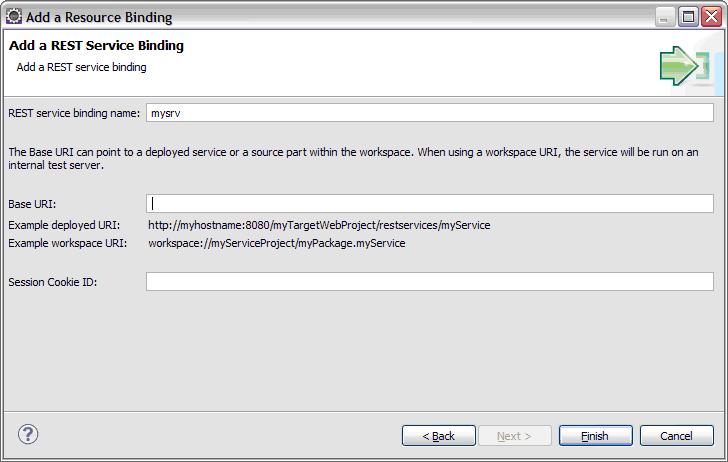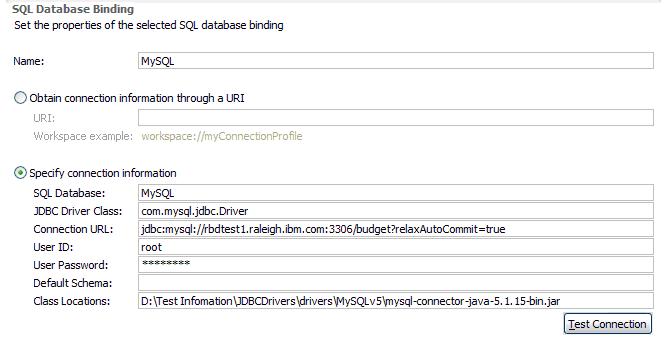Notice: this Wiki will be going read only early in 2024 and edits will no longer be possible. Please see: https://gitlab.eclipse.org/eclipsefdn/helpdesk/-/wikis/Wiki-shutdown-plan for the plan.
EDT:Resource Binding Databases
If the purpose of a resource binding is relational-database connection, the definition is called an SQL database binding.
Contents
Defining an SQL database binding in the EGL deployment descriptor
When you define an SQL database binding in the EGL deployment descriptor, you specify a set of details for use at application run time. In some cases, you also specify a set of server configuration details that are provided to the EGL deployer.
Here is the overall process:
- In an EGL project, expand the EGLSource folder and double-click the deployment descriptor, which has the file extension .egldd.
- Click the Resource Bindings tab. The Resource Bindings Configuraton page is displayed.
- Click Add and, at the Add a Resource Binding page, select SQL Database Binding. The Add an SQL Database Binding page is displayed, as shown here:
[ replace, when possible ]
To specify where the binding details are stored, select one of the first three options:
- To use connection details that are or will be specified in an Eclipse connection profile, select the first option. Reference an existing connection profile or press the New button to define one.
- To specify connection details directly in the binding definition, select the second option instead.
- To use an JNDI data source that is or will be defined in the application server, select the third option. In this case, the details that you specify are the only ones on this page.
If code is running on an application server that is compliant with Java Enterprise Edition, JNDI allows for fast database access across multiple users.
If you intend to deploy your code to the Apache Tomcat server, you can configure a JNDI entry:
- Define most of the binding details by specifying the first or second option; and
- Select the fourth option. The JNDI name and other details that you specify here are associated with the details from the first or second option. The information is packaged during EGL deployment. The deployment establishes a container-based authentication, which means that the server stores any user ID and password needed for database access.
If you select the first option, any subsequent change to the Eclipse connection profile is available to your code at development and deployment time. After the EGL deployer has packaged the application, though, the changes have no effect on the deployed code unless you re-deploy the application.
Retrieving an SQL database binding in your code
You enable a future connection to a database by declaring a connection variable. The connection itself occurs when you first run a database-access statement that uses the variable.
One way to enable a future connection is to retrieve an SQL database binding from the EGL deployment descriptor. For example, here is the declaration of a connection variable:
myDataSource SQLDataSource? { @Resource {bindingKey="MyDatabaseBinding"} };
That declaration is valid whether the binding is for JNDI or not. You can specify a connection variable that is specific to a JNDI data source, but will cause a runtime error if the binding refers to a non-JNDI data source:
myJNDIDataSource SQLJNDIDataSource? { { @Resource {bindingKey="MyDatabaseJNDIBinding"} };
Your code interacts with either variable in the same way, and the use of the SQLDataSource type is sufficient in many cases. Here is an exception: if your subsequent logic uses the EGL isa operator to test whether a variable is of type SQLDataSource or SQLJNDIDataSource, you must use the SQLJNDIDataSource type for JNDI data sources and must use the SQLDataSource type for others.
You can also access SQL database bindings in your logic, as shown here:
myDataSource SQLDataSource? = SysLib.getResource("MyBinding");
myJNDIDataSource SQLDataSource? SysLib.getResource("MyJNDIBinding");
myOtherJNDIDataSource SQLJNDIDataSource? SysLib.getResource("MyOtherJNDIBinding");
Creating an SQL database binding in your code
You can create an SQL database binding in your code, in which case the EGL deployment descriptor is not involved. For example, the following code enables a database connection for a non-JNDI data source:
connectURL string = "jdbc:derby:SomeDB;create=true;";
properties Dictionary{user = "MyID", password = "MyPassword"};
ds SQLDataSource? = new SQLDataSource(connectURL, properties);
Here is equivalent code that is specifically for a JNDI data source, but as noted earlier, the variable type can be SQLDataSource:
connectURL string = "jdbc/myDataSource";
properties Dictionary{user = "MyID", password = "MyPassword"};
ds SQLJNDIDataSource? = new SQLJNDIDataSource(connectURL, properties);
If security detail is passed to a data source that operates under container-managed security, the result is not determined by the EGL-generated code. For details, see the documentation for the data source itself.
Here is the code that enables a JNDI connection in the usual case, when container-managed security is in effect:
connectURL string = "jdbc/myDataSource"; ds SQLJNDIDataSource? = new SQLJNDIDataSource(connectURL);
For details on the HttpRest object, see the help topic named "eglx.http package."
Binding DB with hard-coded
Add database binding
Please refer to section 2.1 for the detail<span style="text-decoration: underline;" />
Select database binding type
Select type of Add the information from the selected connection below(hard-coded information). You can also use the existing database connection or create a new database connection. The completed database binding should like below:
In can also update or exit the database information manually. After updated database information manually, do NOT forget to click the “Test Connection” to verify the database connection worked.
Using the database binding in code
Please refer to section 2.3
Other way to define SQL database connection
Besides the resource binding, we can also define the SQL database connection directly in our source code.
For example:
// the data source includes a connection string, as well as // security details that are stored in a dictionary. connectURL string = "jdbc:derby:SomeDB;create=true;"; properties Dictionary{user = "MyID", password = "MyPassword"}; ds SQLDataSource? = new SQLDataSource(connectURL, properties);
♦ Previous: Service bindings
♦ First: Resource binding introduction
[[Category: EDT]]


